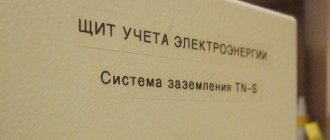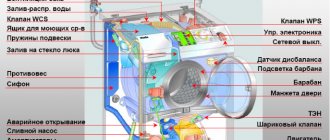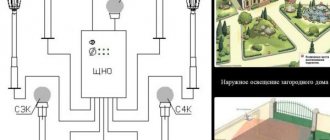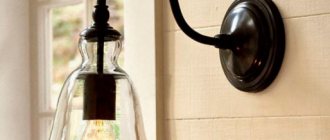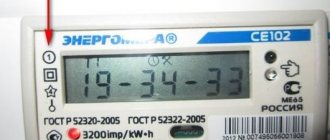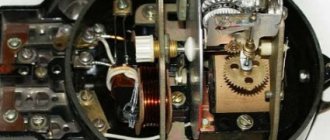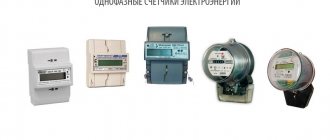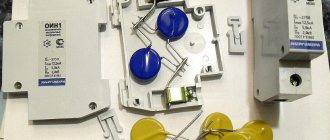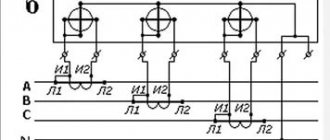Types of electricity meters
The legislation provides for equipping all residential and non-residential buildings with electricity meters; responsibility for this lies with the owner of the premises.
For the convenience of the population, various device options are offered:
- Mechanical or induction. Quite widespread, as they were installed everywhere over a long period of time. They are distinguished by their reliability and durability, but at the moment such IPUs are gradually losing popularity due to their low accuracy class. The principle of operation is the formation of a magnetic field between two coils, which causes the counting mechanism to rotate.
- Electronic. Modern devices guarantee extreme accuracy, since measuring current and voltage does not require the presence of a magnetic field, which eliminates losses. Such an electric meter has many advantages, but in case of failures and fluctuations it can fail.
There are types of IPU depending on the type of nutrition:
- Single-phase. The most common option, suitable for residential and small domestic premises. Mounted on two-wire networks with a standard voltage of 220 volts.
- Three-phase. They are used for technical and industrial facilities, as well as private houses and apartments equipped with powerful electrical appliances. Suitable for three- and four-wire networks with a voltage of 380V.
In the vast majority of cases, private houses and city apartments are equipped with single-phase electricity meters; the use of three-phase metering devices is allowed with a large potential load and a housing area of 100 m² or more
To save money, the following types of electricity meters have been developed:
- Single tariff. Standard option, which takes into account consumption around the clock at a single price.
- Multi-tariff. They are divided into zones according to the time of day: two-tariff and three-tariff. When using electricity at night, significant savings are achieved, but during peak hours the tariff is maximum.
Read more about which electricity meter is best to install in an apartment.
You should know! Service organizations cannot force the owner of the premises to install an IPU, but in this case the payment is calculated according to the standard with an increasing coefficient, which leads to the accrual of significant amounts.
Installation Rules
Installation and connection of the electricity meter is carried out in accordance with the recommendations prescribed in the PUE:
- The room must be dry. If you plan to place it on a pole or the facade of a building, then the device must be marked that it is suitable for outdoor installation at temperatures down to –40 degrees.
- Height from the floor - from 80 to 170 cm. Placement below 0.8 m is allowed, but subject to a 40 cm indentation.
- The mechanism and additional elements are placed in a shield or special box. All parts must be well recorded.
- When connecting an electric meter, you must exclude any illegal connections that could be made to the installation site of the device.
- It is recommended to leave a supply of live wires to ensure convenience during replacement or other actions and to eliminate the need for extension.
- Electrical wiring should not be twisted or soldered; in case of increased fragility of the elements, a complete replacement of the supply section is required.
- The IPU is placed strictly horizontally; distortions can lead to malfunction.
- All wires are marked or connected according to the accepted color identification.
The installation height of the meter indoors and the installation level of the cabinet with the meter outdoors are absolutely the same, the difference lies in the presence or absence of a protective box
Existing requirements must be observed; deviations from the rules that affect operation and safety will result in the impossibility of putting the device into operation.
Rules for installing an electricity meter on a pole
In recent years, more and more often, electric meters are installed on a pole on the street. This is due to the fact that with this method of installing the metering device, it is much easier for employees of energy supply companies to take readings. After all, previously, even in private homes, electricity meters were installed indoors, and in order to gain access to them at the time readings were taken, it was necessary that someone was at home. Otherwise, it was impossible to obtain the data.
When installing meters outside the house, this problem solved itself. Moreover, modern street meters are specifically designed for this, and allow you to monitor the electricity consumed and clarify the readings taken at any time.
It should be noted that installing a metering device (for example, a three-phase meter on the street) requires compliance with certain rules. We will talk about the main ones in this article, and we hope that this information will be useful to you if you decide to install an electricity meter outside your residential premises.
Installation location
For the placement of electrical power supply units, there are standards that regulate the procedure.
Multi-storey building
Such buildings are built in compliance with many technical rules, which guarantees a convenient and safe supply of electricity. A special panel room on the landing is allocated for metering devices.
In modern apartment buildings, IPUs are most often installed directly in the apartment. This not only allows the owner to control the readings, but also ensures the safety of the mechanism, for which the homeowner is responsible.
Private or country house
The most common option for placing an electric meter is a pole from which wires for connection are drawn, which limits the possibility of illegal connection. But since the place is located on the street, ensuring the safety of the device becomes difficult.
It is possible to install the device in a protective box on a special pipe stand or pole in a fenced area. The installation site should not be cluttered or difficult to access.
The law does not prohibit installing an electric power supply directly in the premises, which is especially important for a seasonally visited summer house or a private house that was previously equipped with an electric meter inside. But approval of such work may require going to court, which does not always side with the owner.
Garage
If there is energy-intensive equipment at the facility, a three-phase meter is installed. If the room is used only for storing a vehicle or some things, then single-phase is sufficient.
The placement order depends on the specific situation. Installation of the IPU on the street is allowed: a nearby pole or a special structure is suitable for this. Internal fixation is carried out according to standard connection requirements.
On a note! It is important to ensure unhindered access to the electric energy meter for representatives of the service organization; the protective box should be easy to open for inspection.
Electronic electricity meters: where to install
The current rules stipulate that electricity meters must be installed in dry rooms where the temperature does not fall below zero. This is explained by the fact that exposure of the device to moisture and negative temperatures negatively affects the correct operation of the electric meter. Thus, an electronic meter installed on a street pole in violation of these requirements will begin to work inaccurately over time. But, nevertheless, cases of taking the electric meter outside have become very frequent; in some cases, electric networks even illegally force consumers to do this.
Currently, the user himself determines the location of the electricity meter. This could be a house, a veranda, the facade of a house, or a pillar.
Now energy supply companies require the private sector to install meters on the street on nearby poles. This removal of the metering device outside the house makes it possible to have unhindered access to it at any time. Company employees can go to the electricity meter of any household and take readings even when the owners are not at home. This greatly simplifies the control and accounting procedure, and also allows it to be completed much faster.
It is advisable to install the meter on the border of the balance sheet (determined by mutual agreement of the parties). Such a border can be located either on the facade of the house or on the nearest pole in the yard. In some cases, it is possible to place the meter outside the site (on the street). To do this, you should choose the optimally suitable pole.
It should be noted that the requirements of energy supply companies to move the electricity meter outside in a private house are contrary to the current rules and instructions for installing the meter. Some subscribers defend in court their right to place the meter in the house, while others agree to the transfer.
Installation of an electricity meter in a private house
To connect the meter correctly, you must follow the instructions.
Work order
Placing an IPU in a home requires certain skills. It is important to accurately calculate the planned power, which depends on the availability of electrical equipment. Based on this value, the type of device is determined: single- or three-phase.
Stages of approval and installation:
- An application for the need to connect a building to the power grid is submitted to the appropriate organization. The required power is indicated, supported by calculations, and the model and type of electric meter must be included. The authorized person issues a standard contract and provides the technical conditions necessary for connection. Coordination of individual details may be necessary.
- An individual project is drawn up. For these purposes, a specialist from a sales company or a certified company is involved.
- After clarifying all the nuances and obtaining permission, you can install the box and place an individual meter.
- To seal the electricity meter, if installation work is carried out independently or by a third party, you need to call an energy network employee. He will check the connection and, if everything is correct, will seal it and draw up a corresponding report. From this moment the electric meter is considered to be put into operation.
In the absence of experience and skills, it is recommended to involve specialists.
Taking the device outside
At the moment, due to the requirements of Energosbyt to install the meter not inside the premises, but outside, some disagreements are arising. Various location options are available: façade, pillar or specially erected structure.
Representatives of the company refer to Decree of the Government of the Russian Federation of May 4, 2012 No. 442. Indeed, the law states that IPUs must be installed along the border of the balance sheet ownership of the company’s energy networks and the site of the owner of the facility. This territory means the facade of a building or a boundary pillar, so many owners of private houses are required to take the device outside.
But if the owner does not want to change the location of the electricity meter, the owner can appeal to the PEU, which states that the mechanism must be located in a dry room with a temperature not lower than 0 °C. In addition, the consumer is directly responsible for the safety of the IPU, according to the Civil Code of the Russian Federation and RF PP No. 354. Thus, if the owner provides convenient, unobstructed access to the electric meter, there is no need to reinstall it.
You should know! Since the existing requirements contradict each other, if it is impossible to reach a compromise, the owner must contact the regulatory authority, prosecutor's office or court.
Who pays for the installation of an electric meter in an apartment?
The natural question is, at whose expense is the work being carried out and what is the cost of installing an electric meter in the apartment? The answer will depend on several circumstances. The initiative to replace equipment comes from the property owner, but payment for equipment and installation may be borne by other organizations. The fact is that the rules in this regard change periodically, and the latest innovations are currently being considered. But they have not yet received legal force, and, most likely, the existing rules will remain in effect until 2021.
- Installation of an electricity meter in a municipal apartment
The owner of non-privatized housing is local authorities. In accordance with the Civil Code of the Russian Federation, the owners of real estate, that is, city authorities, must deal with the operation of electricity metering devices.
Citizens living in such apartments on social rental terms are required to pay for the electricity used on time and monitor the condition of metering devices and electrical networks in the apartment.
Often representatives of management companies, referring to Art. 543 of the Civil Code of the Russian Federation, they are trying to shift onto residents not only the responsibility for the safe operation of electricity meters (which does not raise objections), but also their replacement. But the truth is that electricity is supplied to the apartment through the energy receiving installations of the house, which are on the balance sheet of the management company and are maintained by it.
Consequently, the end consumer cannot be considered a subscriber of an energy sales organization. This role is performed by the management company, which operates the electrical equipment. Thus, the costs of replacing an old or broken device must be borne by the management company.
If, based on your application, the management company is in no hurry to install an electric meter in your apartment, then you need to send a complaint to the housing inspectorate.
- Installation of an electric meter in a privatized apartment
In a privatized apartment, the owner is responsible for all equipment (Article 210 of the Civil Code of the Russian Federation). This situation applies when the electric meter is located:
- on the landing or in the common corridor;
- in the shield inside the apartment.
But the management company can also, at its own expense, change electricity meters throughout the house as planned.
- Installation of an electric meter in a communal apartment
Meters in communal apartments can be placed in each tenant’s room, or one common one can be installed for the entire apartment.
The easiest way is when residents have their own individual appliances and pay only for electricity for their needs. If the meter is common, then consumption is divided by the number of residents. It is possible that one of the residents does not pay the bills, as a result of which a debt accumulates, which all residents of the apartment will have to pay off.
To install an electric meter in a communal apartment, you need to find out through the management company who supplies electricity to the house. Then you need to conclude an agreement with the supplier, on the basis of which their specialist will install a meter in your room and connect it to the general network. The final work is a report that indicates the serial number of the installed equipment. After this, you can pay for the electricity consumed using receipts that will be sent to your address.
In accordance with clause 7.1.59 of the “Rules for Installing Electrical Installations,” a communal apartment must have a common meter through which electricity is supplied to the common areas. If you install an individual meter in your room, they will not enter into a separate agreement with you. You can open your personal account only if all residents of the apartment have metering devices in their rooms.
To install an electric meter in a separate room of a communal apartment, you need to spend a lot of time and effort. But this will allow you to pay only for the electricity that you use yourself, and not depend on unscrupulous neighbors, because they will not have the opportunity to transfer their debts to you.
The installation of an electricity meter in a communal apartment is paid for by the property owners.
Do-it-yourself single-phase meter installation
To carry out installation yourself, it is recommended to proceed sequentially.
What will you need?
To work you need to prepare:
- Automatic machines. To shut down in case of an emergency.
- DF or RCD that breaks the circuit during a leak or short circuit.
- Boxing or special cabinet. The option is selected depending on the installation location.
- DIN rails for fixing equipment.
- Adapters, busbars and additional elements for connecting various parts.
- Voltage indicators and limiters.
- Standard set of tools.
- Single-phase electricity meter. The model is selected depending on the situation; devices from the Energomera brand are popular
Carrying out installation work
Installation of equipment and components:
- A box or cabinet is placed in a given place, and parts for hanging are fixed inside. The reliability and rigidity of the structure is checked. It is taken into account that height and accessibility must be respected.
- A two-pole circuit breaker is installed to quickly de-energize the home network. It is installed in front of the IPU, which is stated in the PEU.
- A new metering device is hung on the DIN rail, the evenness and reliability of placement is checked.
- If desired, an RCD is installed. You can skip this step and immediately install single-pole circuit breakers.
- The zero bus is fixed at the bottom of the box, and wires are prepared to create jumpers.
How to connect an electric meter
The equipment must be connected according to the following diagram:
- The supply wire is disconnected and sequentially inserted into the connectors of the two-pole circuit breaker (top). For convenience, you need to use color identification or mark the phase and zero.
- The meter is connected. The order of terminals on the device can be found in the passport.
- A jumper is stretched from the phase contact of the input circuit breaker to the IPU; the connection point on the mechanism is most often located at the very beginning.
- The neutral wire is fixed. It should go from the two-pole machine to the meter terminal (for most products No. 3), but not come into contact with the previous one.
- The phase with the IPU is allocated to single-pole circuit breakers or RCDs (can be located in the system before or after the machines, the second option is more preferable). The zero is fixed to the bus located below.
- (if available) and through the adapter part is immediately sent to the connected equipment, bypassing additional components.
Single-phase meter connection diagram
At this stage, the electricity meter is considered connected. To connect the house, a phase is supplied from the circuit breakers to the distribution box, and a zero from the zero bus.
Attention! All work is carried out with the network de-energized. The wires acting as a jumper are stripped and fixed to the contacts so as to eliminate the protrusion of the bare part. The terminal screws are pulled several times.
Installing an electricity meter on a pole
The installation of an electric meter on a street pole can be done after agreeing on the specific location of its placement (a mandatory condition is that the height from ground level must be in the range of 0.8-1.7 m). Sometimes, to prevent vandalism, meters are mounted at a height of 3 m or more, but such placement is impractical, since taking readings at such a height is extremely inconvenient.
Electrical wires leading to the cabinet must be insulated.
An electrician who has an average level of qualifications can carry out the installation of an electricity meter outside without any problems. The work is carried out in stages in the following order:
Stage No. 1. Input line de-energized
This process is carried out with the consent of the electricity supply organization.
Stage No. 2. Electric wires
The electrical wires are first connected to the circuit breaker, and then directly to the electric meter.
Stage No. 3. Grounding arrangement
This measure is aimed at ensuring the safe operation of all electrical appliances in the house.
Stage No. 4. Wiring connection
At this stage, all wiring to the house is connected to the output of the electric meter.
Each of the stages performed must be carried out in strict accordance with the current norms and rules that apply for carrying out work of this kind.
After the meter is installed on the pole, employees of the energy sales company are invited to seal the electricity meter and register it.
Features of installing an electricity meter in an apartment
To save money, it is recommended to install special devices that record consumption by time zones.
Connection diagram for two-tariff IPU
The procedure for connecting such a mechanism is not very different from a single-phase and three-phase device. The only difference is the larger number of contacts, which requires the use of suitable machines.
Sequencing:
- An input element is built into the system, from which jumpers are connected to the meter.
- RCDs or single-pole circuit breakers are installed. For a three-phase device, a three-phase load circuit breaker is installed in the network.
- The phase contacts are connected to each other, the zero is taken to the bus.
- Setting up. To do this, you need to call a specialist from the energy sales company.
If the owner makes the connection himself, it is important to follow the diagram presented in the technical documentation.
A two-tariff electric meter is connected according to the same scheme as a single-tariff one, but the device requires additional configuration after installation
Technical requirements
For installation, you can buy a ready-made panel. You should follow the basic rules for installing electricity meters:
- the device must be installed in a place that is convenient for inspection or maintenance;
- During installation, the line must be de-energized; this should be ensured in advance by agreement with company representatives;
- the counter should be at a height of 80 to 170 cm from the floor;
- it is necessary to install a safety switch before connecting to the meter, before it;
- grounding is required;
- wiring (machines) are connected to the meter;
- if the integrity of the seals on the meter is broken, you must immediately call a specialist to seal it;
- After installation is complete, a test run is performed.
How to register a new counter
Commissioning of the device is mandatory, otherwise the readings will not be taken into account.
Registration procedure in 2021:
- An application is submitted to the utility service provider (MC, HOA, Energosbyt). The document contains all the IPU information, personal data and address. A copy of the product passport is attached.
- At the appointed time, an employee will come and check the functionality of the mechanism and the correct installation. Adjustments are made if necessary.
- If there are no comments, then sealing is carried out and a corresponding report is drawn up.
- The supporting document is submitted independently or through a specialist to the service company.
After completing all procedures, the electric meter is considered registered and put into operation.
